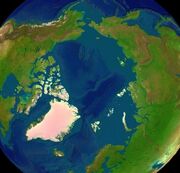| There is more information available on this subject at Arctic on the English Wikipedia. |

Overhead view of the Arctic regions and the nations bordering it.
The Arctic is the region around the Earth's North Pole, opposite the Antarctic region around the South Pole. The Arctic includes the Arctic Ocean (which overlies the North Pole) and parts of Canada, Greenland (a territory of Denmark), Russia, the United States (Alaska), Iceland, Norway, Sweden and Finland. The word Arctic comes from the Greek word arktos (άρκτος), which means bear. This is due to the location of the constellation (a group of stars) Ursa Major, the "Great Bear", above the Arctic region.
Background
There are numerous definitions of the Arctic region. The boundary is generally considered to be north of the Arctic Circle (66° 33’N), which is the approximate limit of the midnight sun and the polar night. Other definitions are based on climate and ecology, such as the 10 °C (50 °F) July isotherm, which roughly corresponds to the tree line in most of the Arctic. Socially and politically, the Arctic region includes the northern territories of the eight Arctic states, including Lapland, although by natural science definitions much of this territory is considered subarctic.

An arctic-based UNSC weather station
The Arctic region consists of a vast ice-covered ocean (which is sometimes considered to be a northern arm of the Atlantic Ocean) surrounded by treeless, frozen ground. Life in the Arctic includes organisms living in the ice, fish and marine mammals, birds, land animals, and human societies. The Arctic region is a unique area among Earth's ecosystems. The cultures in the region and the Arctic indigenous peoples have adapted to its cold and extreme conditions.
The Arctic is home to Halo 3 level Blackout, taking core samples from glaciers and equipped with Doppler Radar for analyzing windspeed.
